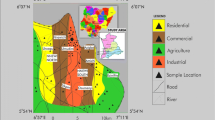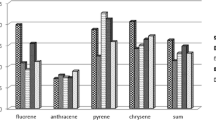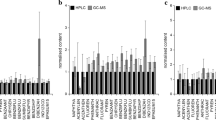Summary
In view of the investigation of contaminated model sites in Baden-Württemberg an inter-laboratory comparison was organized for the methods used for analysing polycyclic aromatic hydrocarbons (PAHs). The laboratories performing chemical and physical analyses at the model sites participated at the request of the Landesanstalt für Umweltschutz, Baden-Württemberg. This inter-laboratory comparison was meant as a first laboratory evaluation, and not as the search for the best method available. Furthermore, it was to show the difficulties in comparing results from different laboratories, which have analysed identical samples. The results of the inter-laboratory comparison between the nine laboratories showed a reproducibility coefficient of variation, for the total of the 16 PAHs according to the EPA, between 48.8 and 61.1% in the concentration range of 5 to 55 mg/kg in the soil samples. One of the laboratories reported significantly lower values compared with the “true value”. This was probably due to an ill-suited (sample) preparation method. Although the results of the inter-laboratory comparison are, in general, satisfactory, the reproducibility can be improved by standardizing the analytical method for the determination of PAHs in solid environmental samples.
Similar content being viewed by others
References
Ministerium für Umwelt Baden-Württemberg (1988) Konzeption zur Behandlung von altlastenverdächtigen Flächen und Altlasten in Baden-Württemberg (Stufenplan). Landtagsdrucksache 10/831, Stuttgart
Neifer H (1988) Modellstandortkonzeption Baden-Württemberg. In: Kongreßband Altlastensanierung '88 TNO/BMFT (11.–15. April 1988), Hamburg
DIN 38409 (1981) Teil 13. Deutsche Einheitsverfahren zur Wasser-, Abwasser- und Schlammuntersuchung; Summarische Wirkungs- und Stoffkenngrößen (Gruppe H); Bestimmung von polycyclischen aromatischen Kohlenwasserstoffen (PAK) im Trinkwasser (H 13)
ISO/DIS 7981 (1989) Water quality — Determination of six specified polynuclear hydrocarbons — Part 1: Thin layer chromatographic method, Part 2: High performance liquid chromatographic method
Landesamt für Wasser und Abfall Nordrhein-Westfalen (1987) Abfallwirtschaft Nr. 13, Bestimmung von polycyclischen aromatischen Kohlenwasserstoffen in Wasser und Feststoffen (PAK), Entwurf, Düsseldorf
Plöger E, Reupert R (1986) Bestimmung von PAK in Wasser, Sedimenten, Schlamm und Abfall mit Hilfe der HPLC. GewässerSchutz-Wasser-Abwasser 88:136–167
Ontwerp NEN 5731 (1991) Soil — determination of the content of ten polycyclic aromatic hydrocarbons by high pressure liquid chromatography. NNI, Delft (in press)
International Standard ISO-5725 (1990) Precision of test method — determination of repetitive and reproducibility for a standard test method by inter-laboratory test
Author information
Authors and Affiliations
Rights and permissions
About this article
Cite this article
Blankenhorn, I., Meijer, D. & van Delft, R.J. Inter-laboratory comparison of methods used for analysing polycyclic aromatic hydrocarbons (PAHs) in soil samples. Fresenius J Anal Chem 343, 497–504 (1992). https://doi.org/10.1007/BF00322157
Received:
Revised:
Issue Date:
DOI: https://doi.org/10.1007/BF00322157




